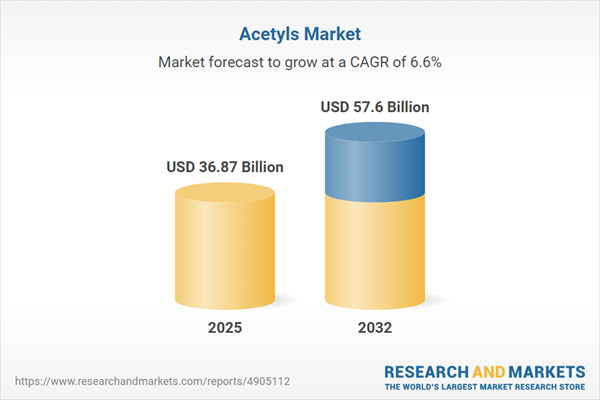Speak directly to the analyst to clarify any post sales queries you may have.
Amid shifting regulations and rising sustainability expectations, senior decision-makers in the acetyls market require a clear view of global trends, risks, and opportunities. Reliable insights are vital to support high-impact strategies, technology adoption plans, and compliance initiatives in this evolving sector.
Acetyls Market Snapshot
The global acetyls market is valued at USD 34.61 billion in 2024 with projected growth to USD 36.87 billion by 2025 and reaching USD 57.60 billion by 2032, reflecting a consistent 6.57% compound annual growth rate.
Expansion is underpinned by increasing demand for acetyl derivatives across adhesives, coatings, and pharmaceutical manufacturing. Investments in sustainable feedstocks and updates to compliance standards are spurring companies to refine procurement processes and logistics, ensuring readiness for regulatory changes and shifting global customer requirements.Acetyls Market Scope & Segmentation
This acetyls market analysis provides targeted intelligence for senior leaders developing procurement, operational, and investment strategies. Comprehensive segmentation illuminates the pivotal factors impacting supply and innovation:
- Product Types: Acetic anhydride, acetyl chloride, butyl acetate, ethyl acetate, methyl acetate, and vinyl acetate monomer are essential for process improvement in adhesives, coatings, and pharmaceuticals while addressing regulatory demands.
- Application Areas: Industrial adhesives, specialty coatings, pharmaceutical manufacturing, textiles, inks, sealants, and packaging enable organizations across diverse sectors to enhance operational efficiency and production quality.
- Purity Grades: Food-grade, pharmaceutical-grade, and industrial-grade acetyls help companies maintain strict audit trails and meet sector-specific compliance obligations in food, healthcare, and manufacturing.
- Regions and Sub-Regions: The Americas, Europe, Middle East & Africa, and Asia-Pacific—each featuring countries such as the U.S., Canada, Germany, UK, China, and India—contribute unique regulatory conditions, supply chain structures, and trading contexts that shape sourcing and compliance efforts.
- Key Companies: Leading organizations—Celanese Corporation, Eastman Chemical Company, LyondellBasell Industries N.V., Mitsubishi Chemical Corporation, Saudi Basic Industries Corporation, BP p.l.c., INEOS Group Holdings S.A., Sasol Limited, Formosa Plastics Corporation, and Sinopec Limited—establish benchmarks influencing technology use and competitive standards regionally and globally.
Adoption of digital technologies, such as integration and traceability platforms, strengthens process standardization. These advancements help maintain quality control, enhance traceability, and prepare organizations for evolving compliance and sustainability objectives across all operating geographies.
Key Takeaways for Senior Leaders
- Implementing agile portfolio strategies enables fast adaptation to complex, multi-regional regulatory requirements and supply disruptions.
- Switching to alternative and bio-based feedstocks builds sustainability resilience while optimizing procurement and reducing dependency on traditional raw materials.
- Digital transformation supports greater visibility across manufacturing and logistics, increasing automation and enhancing real-time compliance monitoring.
- Systematic regulatory review and scenario analysis reduce operational risks and allow organizations to pivot their processes efficiently as standards evolve.
- Tailored risk management and localized approaches help navigate infrastructure variability and ensure compliance across global markets.
- Strategic investments in research, advanced manufacturing technologies, and collaborative ventures advance competitiveness while deepening sector expertise.
Tariff Impact
Renegotiated U.S. tariffs have elevated import costs for acetyl derivatives, prompting manufacturers and suppliers to reconsider established sourcing strategies. In response, industry leaders are boosting domestic capacity, diversifying supply partnerships, and fine-tuning inventory methodologies to support reliable operations amid ongoing trade shifts.
Methodology & Data Sources
This acetyls market report integrates insights from direct interviews with executives and technical specialists. Data triangulation, global regulations review, patent analysis, and advanced forecasting models ensure a robust, transparent foundation for executive decision-making in a dynamic market environment.
Why This Acetyls Market Report Matters
- Enables precise procurement, investment, and operational planning that strengthens competitive advantage and minimizes market risk exposure.
- Guides benchmarking initiatives for sustainability and compliance, empowering organizations to target improvements and align practices across divisions.
- Delivers actionable scenario analysis capabilities so business leaders can proactively address regulatory and supply chain shifts.
Conclusion
For senior leadership, timely and accurate insight into the acetyls sector is essential to support regulatory alignment, digital transformation, and sustainability goals. This report delivers the clarity needed to support resilient business growth in a competitive global marketplace.
Additional Product Information:
- Purchase of this report includes 1 year online access with quarterly updates.
- This report can be updated on request. Please contact our Customer Experience team using the Ask a Question widget on our website.
Table of Contents
3. Executive Summary
4. Market Overview
7. Cumulative Impact of Artificial Intelligence 2025
Companies Mentioned
The companies profiled in this Acetyls market report include:- Celanese Corporation
- Eastman Chemical Company
- LyondellBasell Industries N.V.
- Mitsubishi Chemical Corporation
- Saudi Basic Industries Corporation
- BP p.l.c.
- INEOS Group Holdings S.A.
- Sasol Limited
- Formosa Plastics Corporation
- Sinopec Limited
Table Information
| Report Attribute | Details |
|---|---|
| No. of Pages | 199 |
| Published | November 2025 |
| Forecast Period | 2025 - 2032 |
| Estimated Market Value ( USD | $ 36.87 Billion |
| Forecasted Market Value ( USD | $ 57.6 Billion |
| Compound Annual Growth Rate | 6.5% |
| Regions Covered | Global |
| No. of Companies Mentioned | 11 |









